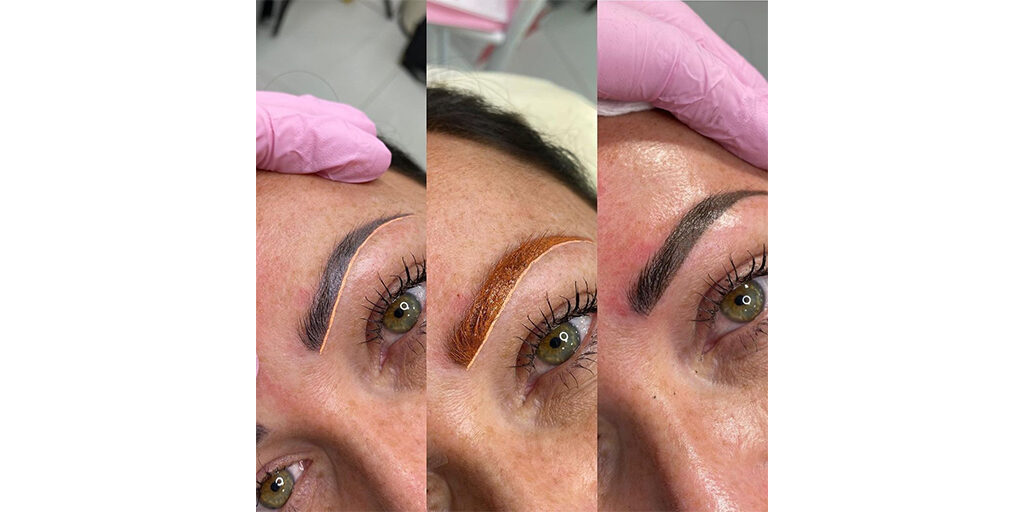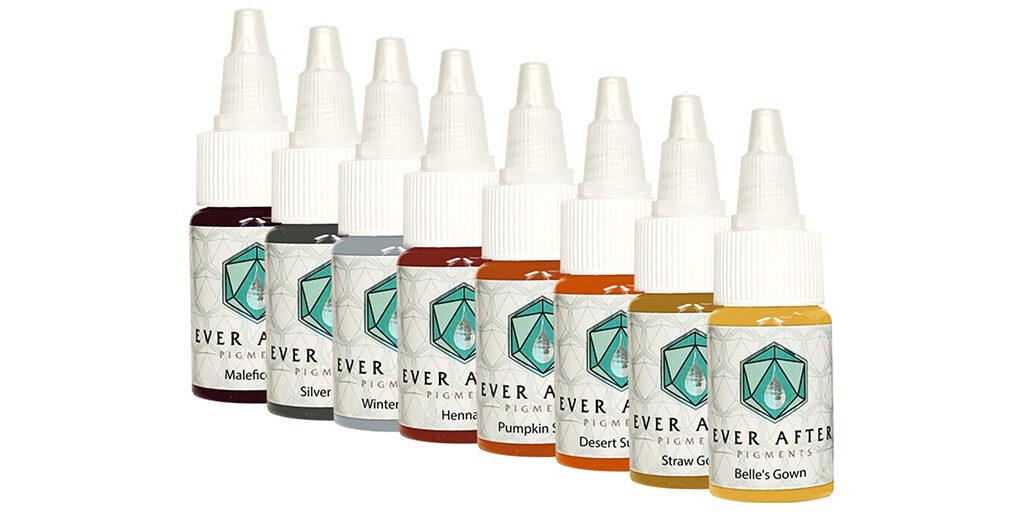What modifiers and correctors do I need in my kit?
In our blog on Colour Theory in permanent makeup, we discuss the importance of understanding colour theory and how the undertones of the skin combined with pigment can affect the colour of healed results.
In When PMU Goes Wrong, we talk you through how to avoid unwanted tones (among other issues) and what to do when a treatment doesn’t go to plan – including colour correction.
High-quality modifying and correcting pigments are an integral part of any PMU artists kit, even for those who do not correct work from another technician yet. But for beginners, they are essential for preventing unwanted tones and correcting them if the need arises at the top-up.

Modifying and correcting pigments can be mixed with a pigment shade to neutralise any strong undertones in the skin and create an even, healed result on your client. Or, they can be added at top-ups if unwanted tones have appeared. They can also be used neat to cover previous PMU for clients with very faded results that do not require complete removal.
Which colour modifier/corrector you require will depend on the client’s undertones or on the unwanted tones you want to correct. To identify the correct modifier, you must first identify the complementary colour of the shade(s) you want to neutralise.

For example, clients with a very cool toned skin type (blue/purple undertones) may require a few drops of a warm orange/yellow modifier mixed with their pigment to avoid brows healing ashy. And clients who present with old PMU that has turned grey or blue, they will also require a warm, orange toned corrector to neutralise the brow.

Vice versa, warm skinned clients (red/pink undertones) may require an olive modifier and clients with faded orange, pink or red brows will require an olive corrector to cover and neutralise.
Below we talk you through some of our best-selling modifiers and correctors and how to use them to produce the best results.
Modifiers for neutralising blue/grey/purple

Perma Blend Pumpkin Corrector
This shade by Perma Blend has been designed for use on previous PMU that has developed intense blue-grey tones. Designed to neutralise, like all Perma Blend products this pigment is stable, easy to apply and fully tested.
Perma Blend Golden Corrector
This shade can be used neat or mixed with another pigment to neutralise softer blue-grey tones that have developed in the brows. This shade has slightly more yellow than Pumpkin, which is an extremely warm orange.
Perma Blend Gourd Corrector
This shade is darker than the Golden Corrector and can be used neat or mixed to target and neutralise green/blue toned brows. This shade also contains no titanium dioxide.
Li Pigments Aqua in Un-Gray
The Aqua range consists of water-based pigments with a smooth, creamy consistency. Un-gray is a very warm pumpkin orange shade that can be used to target stubborn blue/grey brows or to add warmth to an existing pigment.
Li Pigments Aqua in Gray Vanish
Gray Vanish is a warm yellow/orange shade that contains more yellow than Un-Gray. It has been formulated to target light to medium grey or blue tones or to add extra warmth to pigments for all skin tones.
Artyst Corrective Pigment Orange 01
Specifically designed for cover-up work, the Artyst corrective pigments have been developed in collaboration with expert chemists and experienced artists. Orange 01 is a brown-toned orange which is suitable for correcting grey and ash toned brows.
Artyst Corrective Pigment Yellow 01
Yellow 01 in the Artyst Corrective range is a mustard-yellow tone, used to neutralise purple-toned eyebrows.
Modifiers for neutralising pink/red/orange

Perma Blend Olive Corrector
This versatile shade from Perma Blend can be used neat or mixed with other shades to target and neutralise red, orange, or pink toned brows.
Li Pigments Aqua Olive Mod
This modifier from the Aqua range can be used to cover orange, red or pink brows. It can also be added to a red or orange-based pigment to reduce excess warmth.
Artyst Corrective Pigment Olive 01
This shade from the Artyst Corrective collection is a muted, dark green colour which is suitable for correcting brows with red tones.
Cosmetic Ink Pure Colors Olive Mod
This modifier from Pure Colors can be used neat or mixed with other pigments to target orange and pink toned brows. This modifier is cool toned with a yellow/green base.
Modifier Sets

Ever After Modifier Set
This set from Ever After Pigments includes 8 of the most popular modifying and correcting pigment shades. With a mix of cool and warm toned pigments, these pigments can neutralise any unwanted tones to produce natural results.
What about modifiers and correctors for lips?

One of the aims of a lip blush treatment is to restore any lost pigment and add warmth, as most clients will naturally have blue/cool undertones in the lips. So unlike brows, unwanted tones are not as common however modifying may still be required to ensure lip pigments heal true to colour.
Below are some of our top picks for modifying during lip treatments:
Li Pigments Forever Modifiers in Blue Gone
The Forever series from Li Pigments are highly concentrated with a creamy, organic base. A very warm orange shade, Blue Gone is to be used as an additive only to neutralise very cool/blue tones or add warmth. Due to the intensity of colour, we recommend only adding 1 drop at a time!
Li Pigments Forever Modifiers in Purple Gone
To be used only as an additive, Purple Gone can be added to lip pigments to neutralise any purple tones within the lips or to modify for lips with very cool tones.
Artyst Corrective Pigment Orange 02
This shade from the Artyst corrective range can be used neat for dark lip neutralisation treatments (which we will go into more detail about below) or can be added to other cooler toned shades to neutralise.
What is dark lip neutralisation?

As mentioned above, pigment modification may be required if a client has some blue or purple tones in the lips. However, if these tones are intense and prominent, this client will usually require a dark lip neutralisation to achieve their desired result.
Dark lip neutralisation is a form of cosmetic tattooing which involves using permanent makeup pigments to neutralise any dark tones that can occur naturally in the lips. This treatment is more complex than a basic lip blush and it is advised that only highly experienced technicians carry it out.
Lip neutralisation can require up to 4 sessions to achieve the desired result and is a multi-step procedure, with time for healing in between each session. For a successful lip neutralisation, corrective pigments are always required to create the neutral base.
Step One
In the first step of the neutralisation process, the client will usually require a warm bright orange to be used neat on the lips to target the dark tones. Clients with very prominent purple tones may need to undergo a second session using this bright orange or an opaque yellow corrector, if the initial treatment isn’t successful.
Step Two
The second step of the process involves implanting a neat bright red pigment with a cool undertone into the lips. This step may not be required for every client and artists can judge this by assessing healed results after the first session.
Step Three
The initial sessions using the corrective pigments will create a neutral, healed base for the artist to begin working on. At this stage, the client will select their pigment of choice and it can be implanted using a traditional lip blush technique. As they have undergone neutralisation, the chosen shade should now heal evenly and more true-to-colour in the lips, with no dark tones.
One of our top picks for lip neutralisation are the Evenflo Lip Correctors which include the shades Neutralizer (Step 1), Colorizer (Step 2) and Illume (opaque yellow pigment). These pigments can be ordered individually or as a full set and are a go-to for so many artists who offer this treatment.
So, there you have it! Our guide to modifying and correcting pigments and why they are so important in permanent makeup. Plus, some of our top picks for targeting different unwanted tones in brows and for modifying and neutralising the lips.
With these high-quality colours in your kit and with a good understanding of how to use them, your clients are far less likely to experience unwanted tones or disastrous results. Investing in these pigments and using them correctly means you can create neutral, beautiful results on every client!
